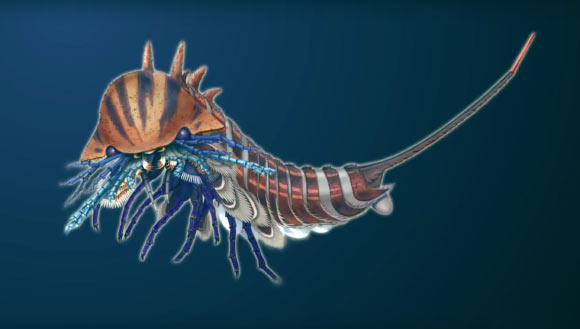Habelia optata, a close relative of the ancestor of modern-day spiders, scorpions and horseshoe crabs, evolved an extremely complex head to hunt and eat shelly animals, according to new research from the University of Toronto, Canada.

Artistic reconstruction of Habelia optata. This creature and its relatives were active predators of the Cambrian sea floors, hunting for small shelly sea creatures, such as small trilobites — arthropods with hard, mineralized exoskeletons that were already very diverse and abundant during Cambrian times. Image credit: Joanna Liang, Royal Ontario Museum.
Habelia optata, a well-armored sea predator of about 2 cm in length with a tail as long as the rest of the body, lived approximately 508 million years ago during the middle Cambrian period.
It comes from the renowned Burgess Shale fossil deposit in British Columbia and belongs to the group of invertebrate animals called arthropods, which also includes such familiar creatures as spiders, insects, lobsters and crabs.
Like all arthropods, Habelia optata features a segmented body with external skeleton and jointed limbs. What remained unclear for many years, however, was the main sub-group of arthropods to which this ancient creature belonged.
Early studies had mentioned mandibulates — a hyperdiverse lineage whose members possess antennae and a pair of specialized appendages known as mandibles, usually used to grasp, squeeze and crush their food. But Habelia optata was later left as one of the typically unresolved arthropods of the Burgess Shale.
In the new study, University of Toronto paleontologists reinvestigated Habelia optata and found that it was instead a close relative of the ancestor of all chelicerates, the other sub-group of arthropods living today, named for the presence of appendages called chelicerae in front of the mouth and used to cut food.
This is mostly due to the overall anatomy of the head in Habelia optata, and the presence of two small chelicerae-like appendages revealed in these fossils.
“Habelia optata now shows in great detail the body architecture from which chelicerates emerged, which allows us to solve some long-standing questions,” said Dr. Cédric Aria, lead author of the study.
“We can now explain why, for instance, horseshoe crabs have a reduced pair of limbs — the chilaria — at the back of their heads. Those are relics of fully-formed appendages, as chelicerates seem to originally have had heads with no less than seven pairs of limbs.”
Dr. Aria and his colleague, Dr. Jean-Bernard Caron, analyzed 41 specimens in total, the majority of which are new specimens acquired by fieldwork parties to the Burgess Shale.
The research illustrates that the well-armored body of Habelia optata, covered in a multitude of different spines, was divided into head, thorax and post-thorax, all bearing different types of appendages.
The thorax displays five pairs of walking legs, while the post-thorax houses rounded appendages likely used in respiration.
“Scorpions and the now-extinct sea scorpions are also chelicerates with bodies divided into three distinct regions,” Dr. Aria said.
“We think that these regions broadly correspond to those of Habelia optata. But a major difference is that scorpions and sea scorpions, like all chelicerates, literally ‘walk on their heads,’ while Habelia optata still had walking appendages in its thorax.”
“This difference in anatomy allowed Habelia optata to evolve an especially complex head that makes this fossil species even more peculiar compared to known chelicerates.”
“The head of Habelia optata contained a series of five appendages made of a large plate with teeth for mastication, a leg-like branch with stiff bristle-like spines for grasping, and an elongate, slender branch modified as a sensory or tactile appendage.”
“This complex apparatus of appendages and jaws made Habelia optata an exceptionally fierce predator for its size. It was likely both very mobile and efficient in tearing apart its preys,” Dr. Aria said.
The research is published in the journal BMC Evolutionary Biology.
_____
Cédric Aria & Jean-Bernard Caron. Mandibulate convergence in an armoured Cambrian stem chelicerate. BMC Evolutionary Biology 2017 (17): 261; doi: 10.1186/s12862-017-1088-7







